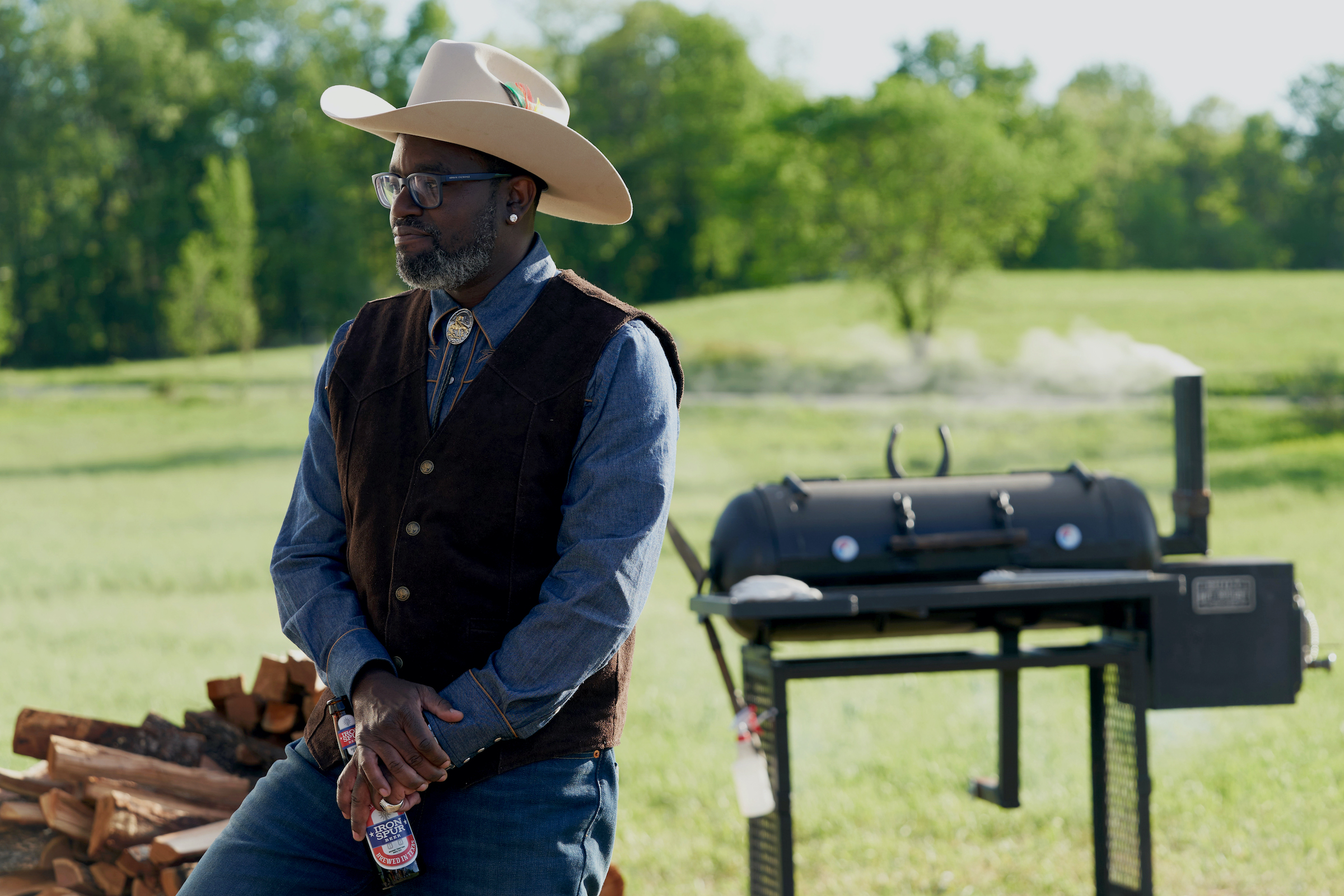The third episode of Poker Face, “The Stall,” may feel awfully familiar.
The title refers to the process of barbecuing meat at low temperatures for long periods of time, during which “a kind of alchemy takes place,” according to George Boyle (Larry Brown). George owns and operates Boyles’ Barbecue, a popular family-run joint in Texas, with his brother, Taffy (Lil Rel Howery). That is, until George has a sudden change of heart after watching the film Okja, decides to become vegan, and asks to be bought out of the family business. That doesn’t sit too well with Taffy, who is mired in dire financial straits. So he follows the only logical course of action: murder his brother.

The plot smacks of another murder mystery episode: Columbo’s “Any Old Port in a Storm.” This time, Adrian (Donald Pleasence) and his half-brother, Rick (Gary Conway), share a family winery, and Adrian is about to be named Wine Society’s Man of the Year—until Rick announces that he wants to sell the land to mass-market wine producers. And Adrian decides, of course, to kill him. (Don’t worry, these aren’t spoilers. Both shows are inverted mysteries, or “howcatchems” rather than “whodunits.” The beginning reveals the murder and the perpetrator, and the suspense lies in how the detective will crack the case.)
Even the murder methods are similar: George and Rick are both knocked out, then suffocated in grisly ways. Undoubtedly, Columbo’s fingerprints are all over Poker Face—creator Rian Johnson, the director behind Glass Onion and Knives Out, has cited “Any Old Port in a Storm” as one of his favorite episodes of past detective programs.
“It gets to the heart of what I think the actual appeal of Columbo is, which is that it’s stealthily a hangout show with Peter Falk,” Johnson told the New York Times about the episode. “You’re tuning in to see Columbo and the guest star interact with each other and hang out.”
Peter Falk played the iconic blue-collar homicide detective Columbo for 10 seasons, between 1968 and 2003. (The original NBC installment aired between 1968 and 1978.) In Poker Face, Natasha Lyonne (Russian Doll, Orange Is the New Black) plays Charlie Cale, a former casino worker with a knack for spotting lies who also solves “case-of-the-week” mysteries. (Like Columbo, the show features a roster of guest stars, including Joseph Gordon-Levitt, Stephanie Hsu, Hong Chau, Dascha Polanco, and Chloë Sevigny.)
Columbo and Charlie have a lot in common: unpolished and unassuming, they downplay their intelligence and ability as they close in on the suspect. They pay close attention and catch lies quickly, then work backward to deduce the how and why. Johnson sees Lyonne as a kind of “modern-day Peter Falk,” he told Rolling Stone: “A strong enough personality to be the center of a show that isn’t one long story.”
But differences abound, too, and Johnson has pointed to a whole host of older shows and characters—including Quantum Leap, Thomas Magnum (Tom Selleck) in Magnum P.I., and Jim Rockford (James Garner) in The Rockford Files—as Poker Face inspirations. These are the shows that raised Johnson, and for which he and Lyonne share a mutual love.
“There’s a whole bunch of shows from that era that are just the idea, really, of a case-of-the week puzzle box,” Lyonne told TIME. “It’s such an iconic character that we’ve seen permutations on that idea for, I don’t know, probably seven decades now, whether it’s Humphrey Bogart or Elliott Gould or Jack Nicholson, and so many others—or Peter Falk.”
Falk’s Columbo was, as Columbo co-creator William Link put it, “a regular Joe.” Columbo is a true everyman: audiences can identify with him, and they like that. Christyne Berzsenyi, the author of Columbo: A Rhetoric of Inquiry with Resistant Responders, has noted that Link denied the show was making an intentional class commentary.
But in Link’s book with Columbo’s other co-creator, Richard Levison, “they talk about how they wanted the everyman, working-class cop going into these contrastive environments; the super wealthy,” Berzsenyi says. “And then he even plays it up more, that he’s kind of folksy and not particularly educated or cultured.”
In Columbo, the suspect and killer—and those surrounding them—are usually upper-class, wealthy, and powerful. Think: a vineyard owner, a famous author, a conductor. Poker Face differs slightly. The murderers in each episode aren’t always wealthy, but they do tend to hold power in some way: a beloved radio show host, retired but famous actors, band members whose hit song everyone knows.

Mathieu Lilian, the author of Columbo: Class Struggle on TV Tonight, says that Columbo “reminds us that all societies are divided in classes, and that there are inequalities between those classes. And it is political, such an idea.”
While Columbo is the type of guy you might sit down and have a cup of coffee with, Lyonne’s Charlie is more likely to crack open a Coors Light with you. Slightly more frayed around the edges, Charlie is on the lam from the law (and a casino magnate), whereas Columbo is a lieutenant with the Los Angeles Police Department.

“Columbo is a police officer, but he is challenging authorities: political, economic control,” Lilian says. “For the TV viewers, people who liked the series, it’s joyful to see such arrogant authorities being challenged.”
Columbo does elicit joy in its viewers, who keep coming back to it 50 years later—perhaps because it feels good to see justice served. Poker Face, on the other hand, achieves a sense of justice in each episode outside of the legal system—something contemporary viewers may find appealing, since it veers from traditional storytelling’s reliance on the carceral system. Either way, both shows leave audiences with a sense of goodwill.
“Genre stories like the crime and detection, the comedy, the historical piece, science fiction, all of these genres, they have certain things that are formulaic about them, and that brings a kind of predictability,” Berzsenyi says. “Or you know what to expect. And you keep going back to something that gives viewers pleasure.”
In Berzsenyi’s studies, she’s come across others—physicians, financiers, preachers—who use the “Columbo method” with their patients, clients, or congregants. They ask a lot of questions, pay very close attention, and then watch for details and inconsistencies. David Martin-Jones, who wrote Columbo: Paying Attention 24/7, says that Columbo taught us how to live in a way that anticipated the modern 24/7 attention economy.
“Consider how Columbo spends hours and hours going over security footage to find the one clue which will catch the murderer,” Martin-Jones wrote in an email. “This intensity of attentive labor anticipated our lives now, paying attention to screens for so much of our working and private lives.”
In Poker Face, though—a great homage to Columbo and shows like it—Charlie is forced to go off the grid, leaving her phone behind. For as much as this new show has to say about its predecessors, it’s still creating a new world entirely its own.
—Judy Berman contributed reporting
More Must-Reads from TIME
- Donald Trump Is TIME's 2024 Person of the Year
- Why We Chose Trump as Person of the Year
- Is Intermittent Fasting Good or Bad for You?
- The 100 Must-Read Books of 2024
- The 20 Best Christmas TV Episodes
- Column: If Optimism Feels Ridiculous Now, Try Hope
- The Future of Climate Action Is Trade Policy
- Merle Bombardieri Is Helping People Make the Baby Decision
Contact us at letters@time.com